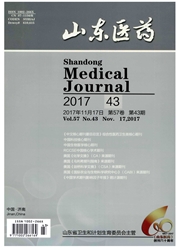

 中文摘要:
中文摘要:
目的探讨竹节参总皂苷治疗关节炎的可行性和作用机制。方法将40只雄性Wistar大鼠随机分为空白对照组、模型组、白芍总苷组、竹节参总皂苷低剂量组和高剂量组,每组8只。空白对照组不做任何处理,余组建立弗氏完全佐剂诱导的佐剂关节炎模型,造模成功后第14天开始给药,高、低剂量组分别每天予竹节参总皂苷200、50mg/kg灌胃,白芍总苷组予白芍总苷50mg/kg灌胃;模型组予等量生理盐水灌胃,灌胃时间均为7d。造模后第12天开始,每隔3d测量各组左右足容积,计算足肿胀率。于造模后第21天采用ELISA法测定各组血清TNF-α和IL-1β水平。结果造模后21d,白芍总苷组、高、低剂量组足肿胀率均低于模型组,高剂量组明显低于其他各组。血清TNF-α和IL-1β水平模型组均高于其他各组(P均〈0.05);高剂量组最低(P〈0.01)。结论竹节参总皂苷治疗大鼠佐剂关节炎效果确切,作用机制可能为下调血清TNF-α与IL-1β表达水平。
 英文摘要:
英文摘要:
Objective To investigate the feasibility and mechanism of total saponins of Panax Japonicas (TSPJ) in treating the arthritis. Methods Forty rats were randomly divided into the normal control group, model control group, total gluco-sides of paeony(TGSP) group,TSPJ low-dose and high-dose group with 8 rats in each. A model of experimental Freund's complete adjuvant-induced arthritic rats was established in the latter four groups ,and were treated with normal saline ,50 mg/kg TGSP and 200,50 mg/kg TSPJ by intragastric administration 14 days later. The rate of paw swell were observed and the serum TNF-α and IL-1β levels were determined. Results Compared with the model control group, the rate of paw swell and serum TNF-α and IL-1β levels in TGSP group ,TSPJ low-dose and high-dose group decreased significantly( P 〈 0.01,0.05 ), particular which in the TSPJ high-dose group (P 〈 0.01 ). Conclusions TSPJ can treat the artthritis rats effectively ,possible mechanism maybe down-regulate the serum TNF-α and IL-1β levels.
 同期刊论文项目
同期刊论文项目
 同项目期刊论文
同项目期刊论文
 期刊信息
期刊信息
